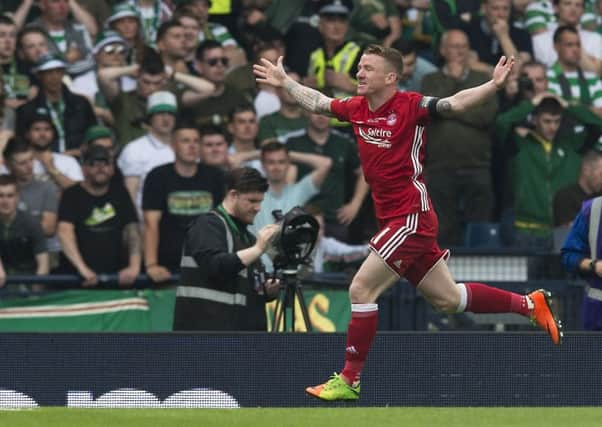What Celtic are getting in Aberdeen winger Jonny Hayes
This article contains affiliate links. We may earn a small commission on items purchased through this article, but that does not affect our editorial judgement.


Celtic fans will already be very familiar with Jonny Hayes. Even for those who take little notice of opposition players and focus only on the men in green and white hoops, it would have been very hard to ignore the fast-as-lightning, direct-running, thunder-striking wide man in the bright red shirt.
Advertisement
Hide AdAdvertisement
Hide AdNo, introductions are not necessary. The real question is: will he be a good signing for Celtic?
On the surface it sounds startlingly obvious. Of course he would be. After all, Hayes would be a great signing (maybe the best signing) for every other club in Scotland this summer had they been the ones to acquire him.
But that’s now the issue. Having completed Scottish football, to borrow video-game parlance, Celtic are setting their sights higher than merely going a full season undefeated and winning every single domestic competition. They want to have another crack at the Champions League group stage, and they want to make a greater impact while they’re there.
In that regard, a soon-to-be 30-year-old from the Ladbrokes Premiership is not what a lot of fans had in mind. They were expecting arrivals of the Scott Sinclair mould; someone with English Premier League (or equivalent) pedigree who could take his game up a notch under the teachings of the football grandmaster that is Brendan Rodgers. If all they get is players of the Hayes standard, there will be disappointment among the support.
But it’s far too early for gnashing of teeth. There’s still a long way to go in this transfer window, and still weeks until Celtic’s deadline to register players for their Champions League qualification third round match (they enter at the second round, but the current side should have no problem advancing through that).
Chances are Hayes has been signed as a squad player: the back-up to Sinclair on the left flank; someone capable of bringing pace and energy off the bench; a different option to the leading man (Sinclair likes to attack inside; Hayes is a more natural wide player), and someone who can fill in on both wings, or even in centre-midfield.
It would be a big surprise if, at the end of the window, Celtic haven’t gone out and bought a new star right midfielder to battle James Forrest on the other flank, giving the squad a complete set of four excellent wide players. If that’s the case, then everyone should look upon this signing positively.
So, exactly what type of production will Celtic be getting from their new winger?
Advertisement
Hide AdAdvertisement
Hide AdTo compare Hayes with what Celtic had in their squad last season, he’s a mix of James Forrest and Patrick Roberts. He’s fast and direct like the former, but has a better final ball and is more adept at using his body to slither beyond defenders, like Roberts.
It was highly surprising to read that, for the 2016/17 Ladbrokes Premiership season, Forrest was statistically the more accurate crosser of the ball by a narrow margin. However, that’s where isolated advanced statistics can sometimes be a little misleading. While Forrest had a 1.77 per cent advantage over Hayes in terms of successful deliveries into the box, the Aberdeen man crossed almost twice as many times a game (6.3 average over 90 minutes compared to 3.7 for Forrest).
It stands to reason that, compared with his Celtic counterparts, Hayes was more likely to cross in desperate situations, where there’s a lower chance of success, or instances where he had fewer available targets in which to aim for. When Forrest crossed the ball, not only was there little need for him to sling it in on a whim, as Celtic would dominate attacking possession and could easily build from elsewhere, he also would have had more bodies to aim for and would have been doing so closer to goal - an assertion backed up by Forrest having more touches of the ball than Hayes, per 90 minutes, inside the penalty area.
Furthermore, Hayes was heavily relied upon for his team to be successful. At Pittodrie it was often remarked that if neither Hayes nor Niall McGinn played well, then Aberdeen weren’t going to win. At Parkhead, it didn’t matter who played poorly, in a domestic context Celtic still won.
Of the other statistics, Hayes matches up fairly well. He engaged in more one-on-one dribbles than Forrest, though not Roberts, and did so more successfully than either Celtic man, whom he also enjoyed a greater shot percentage over. He was a much weaker passer, percentage wise, but again it can be put down to Hayes generally having to hit the ball longer to find its intended target.
All in all, he had an outstanding season on a weaker team, leading the league in assists and bagging 11 goals in all competitions, and it’ll be interesting to see if he can take his game to the next level, even at age 30, with a stronger supporting cast.
The best advice this writer can give to Celtic fans is this: don’t get overly concerned with the bigger picture just yet. There’s plenty of time for that. Hayes is a terrifically fun player to watch. Not only is he fast as lightning, he plays with a great urgency and energy which naturally draws your eyes to him. He works harder than most wingers you’ll come across, always willing to battle for possession, which aids his versatility. And, what’s more, he’s a likeable character. He’ll be a credit to the club.
